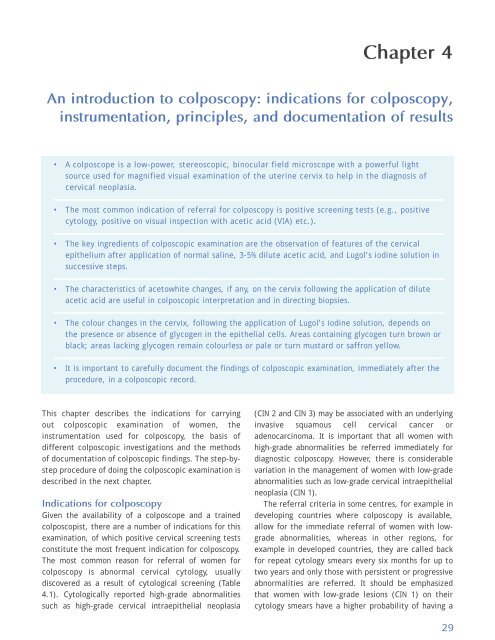Colposcopy and Treatment of Cervical Intraepithelial Neoplasia - RHO
Colposcopy and Treatment of Cervical Intraepithelial Neoplasia - RHO
Colposcopy and Treatment of Cervical Intraepithelial Neoplasia - RHO
Create successful ePaper yourself
Turn your PDF publications into a flip-book with our unique Google optimized e-Paper software.
Chapter 4<br />
An introduction to colposcopy: indications for colposcopy,<br />
instrumentation, principles, <strong>and</strong> documentation <strong>of</strong> results<br />
• A colposcope is a low-power, stereoscopic, binocular field microscope with a powerful light<br />
source used for magnified visual examination <strong>of</strong> the uterine cervix to help in the diagnosis <strong>of</strong><br />
cervical neoplasia.<br />
• The most common indication <strong>of</strong> referral for colposcopy is positive screening tests (e.g., positive<br />
cytology, positive on visual inspection with acetic acid (VIA) etc.).<br />
• The key ingredients <strong>of</strong> colposcopic examination are the observation <strong>of</strong> features <strong>of</strong> the cervical<br />
epithelium after application <strong>of</strong> normal saline, 3-5% dilute acetic acid, <strong>and</strong> Lugol’s iodine solution in<br />
successive steps.<br />
• The characteristics <strong>of</strong> acetowhite changes, if any, on the cervix following the application <strong>of</strong> dilute<br />
acetic acid are useful in colposcopic interpretation <strong>and</strong> in directing biopsies.<br />
• The colour changes in the cervix, following the application <strong>of</strong> Lugol’s iodine solution, depends on<br />
the presence or absence <strong>of</strong> glycogen in the epithelial cells. Areas containing glycogen turn brown or<br />
black; areas lacking glycogen remain colourless or pale or turn mustard or saffron yellow.<br />
• It is important to carefully document the findings <strong>of</strong> colposcopic examination, immediately after the<br />
procedure, in a colposcopic record.<br />
This chapter describes the indications for carrying<br />
out colposcopic examination <strong>of</strong> women, the<br />
instrumentation used for colposcopy, the basis <strong>of</strong><br />
different colposcopic investigations <strong>and</strong> the methods<br />
<strong>of</strong> documentation <strong>of</strong> colposcopic findings. The step-bystep<br />
procedure <strong>of</strong> doing the colposcopic examination is<br />
described in the next chapter.<br />
Indications for colposcopy<br />
Given the availability <strong>of</strong> a colposcope <strong>and</strong> a trained<br />
colposcopist, there are a number <strong>of</strong> indications for this<br />
examination, <strong>of</strong> which positive cervical screening tests<br />
constitute the most frequent indication for colposcopy.<br />
The most common reason for referral <strong>of</strong> women for<br />
colposcopy is abnormal cervical cytology, usually<br />
discovered as a result <strong>of</strong> cytological screening (Table<br />
4.1). Cytologically reported high-grade abnormalities<br />
such as high-grade cervical intraepithelial neoplasia<br />
(CIN 2 <strong>and</strong> CIN 3) may be associated with an underlying<br />
invasive squamous cell cervical cancer or<br />
adenocarcinoma. It is important that all women with<br />
high-grade abnormalities be referred immediately for<br />
diagnostic colposcopy. However, there is considerable<br />
variation in the management <strong>of</strong> women with low-grade<br />
abnormalities such as low-grade cervical intraepithelial<br />
neoplasia (CIN 1).<br />
The referral criteria in some centres, for example in<br />
developing countries where colposcopy is available,<br />
allow for the immediate referral <strong>of</strong> women with lowgrade<br />
abnormalities, whereas in other regions, for<br />
example in developed countries, they are called back<br />
for repeat cytology smears every six months for up to<br />
two years <strong>and</strong> only those with persistent or progressive<br />
abnormalities are referred. It should be emphasized<br />
that women with low-grade lesions (CIN 1) on their<br />
cytology smears have a higher probability <strong>of</strong> having a<br />
29
















